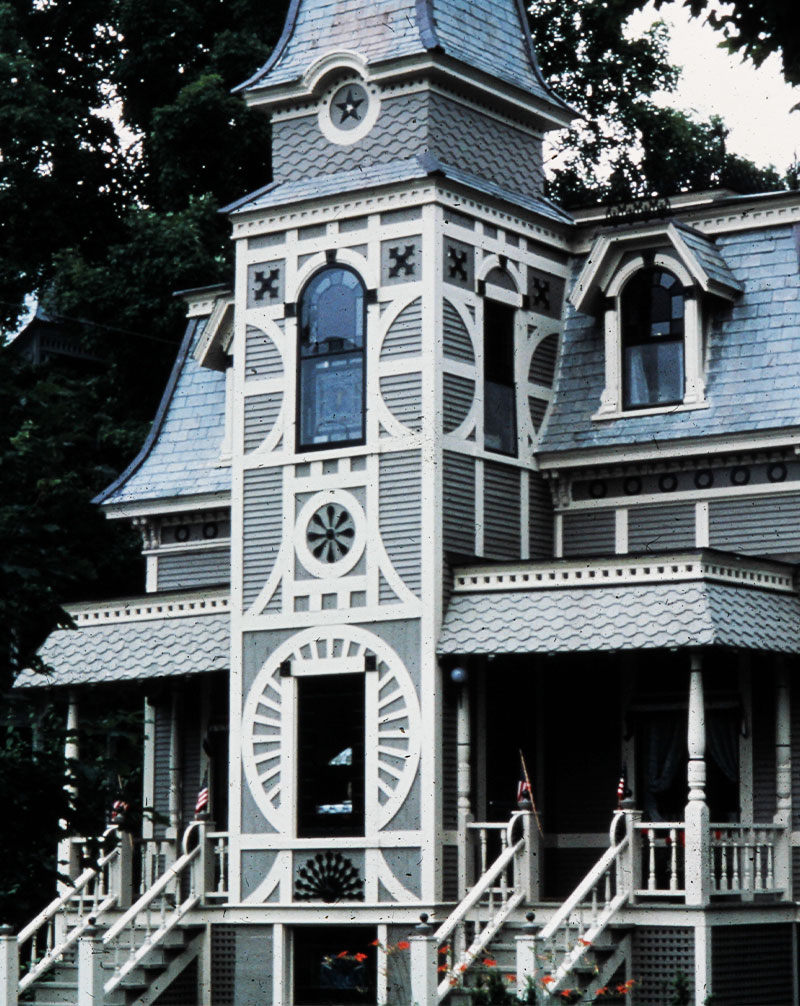how it works
historic preservationprocess of designation
The National Register of Historic places
Through a process called designation, the United States federal government acknowledges structures and sites whose characteristics are considered historically significant and merit placement on the official list called the National Register of Historic Places. State and city governments also grant such recognition with their own registers or historic resource inventories. Stamford recently established a Cultural Resources Inventory to record and protect historic resources in the city.
A building or structure, or site can be deemed historically significant based on:
- its architectural uniqueness;
- as the last remaining representative of a particular style or aspect of history;
- for its association with historical figures or events that contributed to the collective history of a neighborhood, city, state or the country as a whole.
Significance can also be accorded to groupings of buildings, which are called historic districts.
Designation requires documentation of this significance in the form of a scholarly “nomination report” that states explicitly the particular ways the unique or common elements and time period of a building, structure or landscape are worthy of recognition.
Stronger Protection Comes Down to States and Cities
Federal designation on the National Register is largely an honorarium–it alone cannot prevent demolition or alteration. Actual levels of legal protection vary because state and local governments can add protections against demolition or alteration for areas under their jurisdiction.
Buildings become eligible for designation when they reach 50 years of age, but it should be said that not all 50-year-old buildings are “historic” (worthy of designation as landmarks). Local governmental entities, however, can set shorter or longer wait times for designation. In New York City the minimum age is 30 years. The minimum age for Federal designation is 50 years. In most states and cities, the minimum age requirement is also 50 years–as is Connecticut’s
Learn more about requirements for the CT State Register of Historic Places >

“Collaboration, listening and mutual respect make project proponents less likely to be intractable and residents less likely to feel like they have no alternative but opposition.”

In the 21st Century, more and more savvy political leaders recognize that the most successful cities empower their citizens by giving local people a say in how their neighborhood grows and changes. But in the past, it often took a celebrity to champion the local sense of place.
It was during the 1960s that historic preservation gained momentum and legal clout. After New York City lost the magnificent Beaux Arts Penn Station to a developer to make way for Madison Square Garden, big names such as Jackie Kennedy Onassis and Walter Cronkite took up the fight that saved Grand Central Terminal in which the Supreme Court of the United States established that preservation of the built environment was indeed a legitimate public interest.
Since then there has been progress in addressing preservation and citizen input issues. Many states and municipalities have put in place laws requiring citizen input into the planning process and preservation issues as requirements in determining and measuring environmental effects on the natural and built environments.
In recent decades, Architects and other practitioners have documented the economic, environmental and social benefits of restoring, renovating and repurposing historic buildings. This is called adaptive reuse.
More and more governments and people appreciate and are integrating the new among the old. This multi-disciplinary literature has contributed to the elevation of historic preservation as one component in frameworks for:
• managing growth and maintaining, a sense of place
• social cohesion and cultural identity cohesion
“Adaptive reuse” is the act of finding a new purpose for an existing structure. For example, taking an old navy barracks and turning it into a high school would be the process of adaptive reuse. There are thousands of unused structures across the United States—factories, office buildings, shopping malls, train stations—that offer an opportunity for creating a new space without actually constructing a new building.
preservation efforts
History of The South End
449 Contributing buildings
South End evolved into an industrial hub that nourished a largely mixed-income and working class neighborhood.) When the Yale & Towne Lock Works built its factory in 1868 on what had until then been largely estates and farmland in Stamford’s South End.
Yale and Towne’s choice of location stimulated residential development on adjacent land, and the proximity of industry and residential uses established a “walking city” where immigrants lived and worked.
The South End became “the most ethnically diverse of Stamford’s neighborhoods,” as waves of Irish, Italians, Germans, English, Polish, Jews, Swedes, Hungarians, Lithuanians, Greeks and Russians, one after another, settled and stayed until World War II.
Blacks began settling there during the war and Hispanics came in the 1950s. By 1970, it was both the first area of Stamford to become predominantly Black, and housed more than 50 percent of Stamford’s Black population. By 1986, when the South End historic district was established, Blacks were the second largest group of South End residents.
The South End was Stamford’s first neighborhood to be designated as a National Register Historic District, with 449 buildings that were deemed to be “contributing” to the historic character of the neighborhood. Since the creation of the historic district, however, longtime residents–both homeowners and renters–have seen many of their mostly low-rise and historic houses replaced with high-rise apartment buildings.
The 2018 South End Neighborhood Plan explicitly stated that “Protection of and reinvestment in the remaining historic district buildings [is a priority] in order to avoid permanent erasure of character, community culture, and affordable homes and retail spaces.”
Much of the South End Historic District’s sense of place is now permanently lost. Only three out of 50 original Yale and Towne industrial buildings remain and apartment buildings that garner high rents have replaced longtime single and multi-family houses and their tenants.
We encourage Stamford’s citizens to discuss these issues with each other, to speak up publicly to ask questions and challenge proposed changes in your neighborhood. They do affect your lives, so take part in shaping future development in ways that work for you and your community.
A PARTIAL VICTORY
hen historic properties are threatened with demolition, a state law called the Connecticut Environmental Protection Act(CEPA) “allows anyone to sue to prevent the unreasonable destruction of historic structures and landmarks of the state,’” those that merit historic status because of their contribution to state history. In 2020, HNP and Stamford’s Historic Preservation Advisory Commission worked with the State Historic Preservation Office(SHPO) and Preservation Connecticut, appealing to State Attorney General William Tong–whose willingness to take up the case activated CEPA in opposing demolition of three buildings in Stamford’s South End Historic District by the property owner, developer Building and Land Technology(BLT). Under CEPA, the Attorney General can take a property owner to court by filing an injunction against demolition or alteration.
In the 1986 nomination report that formed the basis for designating Stamford’s South End Historic District, the Blickensderfer Typewriter Factory was deemed significant in and of itself. Its attached Schick Annex was said not to be a contributing building simply because at that time it was not yet 50 years old. The two houses were considered contributing as part of an intact, contiguous grouping of vernacular-style houses in the historic district, meaning that they are officially recognized as having historic significance. More than 1,000 people let the attorney general’s office know–with petitions, letters, phone calls and meetings–that these buildings have meaning for them, so his office went to bat for “the Blick” and the other buildings. But minimizing losses and maximizing gains requires flexibility and openness to compromise.
According to Attorney General Tong, because a loss in court could be total–meaning that using a building, issue or condition as leverage in a court case could result in losing all the buildings in question instead of only the most significant one–he may decide to take on a case depending whether the government has a good chance of winning in court against property owners.
In this case, BLT owns the buildings and since the city did not have stronger legal protections in place to save all three buildings, the company had the right to demolish them. To complicate things further, because BLT has targeted the Blickensderfer building for residential rather than commercial use, PCB contamination lies under the whole Schick Annex and a third of the original Blickensderfer building. BLT insists that it must be removed, however, it has another option–to cap the contamination, which is commonly done for both residential and commercial development.
The A.G.’s office decided to negotiate; it required BLT to put up $100,000 for capital investment in the community. This money will go to improvements in the “battered” South End. No one said this would be easy. The case before the A.G. indicated that the best they might hope for would be saving the original part of the Blickensderfer building, but not the attached Schick Annex or the two houses. But by August of 2021, BLT had demolished the Schick Annex and both houses.
what's happening now
In acknowledging the city’s efforts to get control of development in the South End, the Stamford Advocate characterized the impact on the area by developer Building and Land Technology as a “drastic change.”
In 2017, Ralph Blessing, Stamford’s Land Use Bureau Chief oversaw a city effort to get recommendations on how to develop the remaining parcels held by BLT. Since then the city has partially overhauled a city ordinance that will provide more protections to historic buildings and districts.
The year 2021 in Stamford began with an opportunity to increase protections for historic buildings and districts. HNP has been honored to work closely with Mr. Blessing, Senior Planner Vineeta Mathur, the city’s Historic Preservation Advisory Commission (HPAC) and the public to amend a city ordinance that aims to change the pattern of demolition and character-destroying development.
The ordinance, known as “Section 7.3,” strengthens the system of carrots and sticks that developers and other owners must adhere to, and is designed to “preserve, enhance and adaptively reuse Stamford’s historic structures and sites . . . and support contextual development and redevelopment within historic districts.” It provides higher density (more apartments) to those renovating historic buildings in exchange for including affordable housing in an historic building, but prevents the developer from building a larger structure (more floor area) than is allowed for the demolished existing building on the site.
The amended ordinance also establishes:
-
a Cultural Resources Inventory (CRI), Stamford’s own official register of historic properties in the city, which will offer added protections from demolition.
-
an Historic Preservation Trust Fund, which will help to fund preservation of historic structures by requiring a fee from applicants and institutions seeking relief from development standards or addition to the CRI.
- a new rule that discourages demolition of historic buildings by limiting the floor area of any new building replacing an historic one to that contained within the original building.
-
A board of trustees that will manage the Preservation Trust Fund and CRI and adjudicate the placement of buildings on the list.
Address
65 High Ridge STE 368, Stamford, CT 06905















